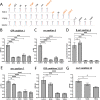A polycistronic transgene design for combinatorial genetic perturbations from a single transcript in Drosophila
- PMID: 37267433
- PMCID: PMC10266610
- DOI: 10.1371/journal.pgen.1010792
A polycistronic transgene design for combinatorial genetic perturbations from a single transcript in Drosophila
Abstract
Experimental models that capture the genetic complexity of human disease and allow mechanistic explorations of the underlying cell, tissue, and organ interactions are crucial to furthering our understanding of disease biology. Such models require combinatorial manipulations of multiple genes, often in more than one tissue at once. The ability to perform complex genetic manipulations in vivo is a key strength of Drosophila, where many tools for sophisticated and orthogonal genetic perturbations exist. However, combining the large number of transgenes required to establish more representative disease models and conducting mechanistic studies in these already complex genetic backgrounds is challenging. Here we present a design that pushes the limits of Drosophila genetics by allowing targeted combinatorial ectopic expression and knockdown of multiple genes from a single inducible transgene. The polycistronic transcript encoded by this transgene includes a synthetic short hairpin cluster cloned within an intron placed at the 5' end of the transcript, followed by two protein-coding sequences separated by the T2A sequence that mediates ribosome skipping. This technology is particularly useful for modeling genetically complex diseases like cancer, which typically involve concurrent activation of multiple oncogenes and loss of multiple tumor suppressors. Furthermore, consolidating multiple genetic perturbations into a single transgene further streamlines the ability to perform combinatorial genetic manipulations and makes it readily adaptable to a broad palette of transgenic systems. This flexible design for combinatorial genetic perturbations will also be a valuable tool for functionally exploring multigenic gene signatures identified from omics studies of human disease and creating humanized Drosophila models to characterize disease-associated variants in human genes. It can also be adapted for studying biological processes underlying normal tissue homeostasis and development that require simultaneous manipulation of many genes.
Copyright: © 2023 Teague et al. This is an open access article distributed under the terms of the Creative Commons Attribution License, which permits unrestricted use, distribution, and reproduction in any medium, provided the original author and source are credited.
Conflict of interest statement
The authors have declared that no competing interests exist.
Figures




References
Publication types
MeSH terms
Grants and funding
LinkOut - more resources
Full Text Sources
Molecular Biology Databases
Research Materials

